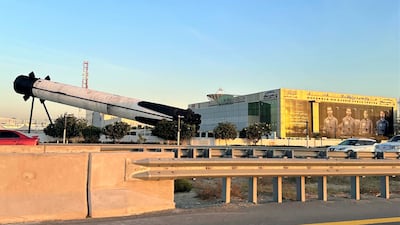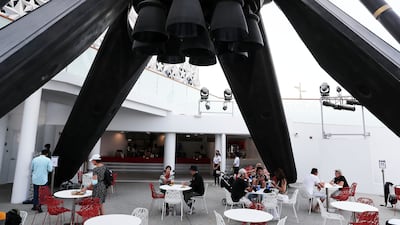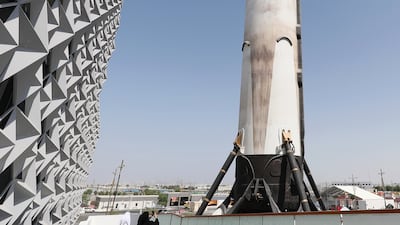For astronaut Steve Bowen, the idea of living on the Moon or travelling to Mars isn't just science fiction – it's an imminent reality.
“I believe we have the technology and capability to embark on a Mars mission now,” says Mr Bowen, commander of Nasa's SpaceX Crew-6 Mission that ferried a team of astronauts -including the UAE's Sultan Al Neyadi – to the International Space Station.
The submariner-turned-astronaut, who has plumbed the depths of Earth's oceans and rocketed to the stars, points to recent international agreements that will allow for the creation of a lunar station as well as a mission to the Red Planet.
The new station is part of plans by the International Artemis Alliance to return humans to the Moon. Alliance members include 40 countries, including the US and UAE.
The UAE's Mohammed bin Rashid Space Centre has signed a deal to construct an airlock that will be used on a lunar-orbiting station being developed by Nasa.
The MBRSC will work with international companies to develop the airlock, the price of which has not been revealed, although it could cost as much as $100 million.
“The Artemis programme's aim is not only to return humans to the Moon but also to establish a foundation for further exploration, making the lunar station a gateway to Mars and the solar system,” Mr Bowen says.
“The human space station on the Moon is planned to be the first international outpost, 250,000 miles [402,000km] from Earth, and will then be merely a launching point for Mars and the rest of the solar system.
“We're paving the way for not just lunar exploration but also setting the foundation for eventual Mars missions and beyond.”
With 227 days in space and about 66 hours spent on 10 extravehicular activities – Nasa-speak for spacewalks – Mr Bowen knows better than most the potential challenges that could arise from venturing farther into the cosmos.
“The challenge lies in committing to and overcoming environmental, nutritional and radiation hurdles in space,” he says.
An astronaut on a mission to Mars could receive radiation doses up to 700 times higher than on Earth, according to the European Space Agency.
Other problems include the stress on the human body due to long periods of living in microgravity, which include bone loss, muscle atrophy and cardiovascular issues.
“So, the faster we can get from Earth to Mars, the better for the future of human space exploration” Mr Bowen says.
“I believe that long journeys in space are not beyond our capabilities any more. I believe it is just a matter of committing ourselves and the resources necessary to accomplish it.”
An important step towards making it possible, he says, is international co-operation, as space exploration is not only difficult but also expensive.
“Optimising the resources and benefiting from all the efforts is great for each country that participates and ultimately for all of humanity,” he explains.
Watch five top moments of Sultan Al Neyadi’s historic space mission – video
“It is clear that the greater the number of participants, the lower the individual costs.”
But it's not only about the cost.
“Each country's contribution brings something else to the discussion, as we look at things differently, and in space we need different ways of looking at different problems,” Mr Bowen explains.
“Each international contribution to space exploration programmes represents a different way of solving some issues. Working together truly leads to a stronger mission.
“Look at the International Space Station: 16 countries working together. Now, the International Space Station has been orbiting the Earth for 23 years, meaning we have approached the quarter century of permanent human presence in space thanks to our co-operation.”
During his time on the ISS, he came to realise “the immense capability” humans have when they work together.
“From carrying buckets of cement to building a platform in space, it's a testament to what humanity can achieve,” he says.
Perhaps nothing illustrated the beauty and importance of international co-operation more than when he shared meals with his fellow astronauts on board the ISS. He recalls, in particular, a meal with Dr Al Neyadi of the UAE that included dishes from his home country.
SpaceX rocket model has a new home at the Mohammed bin Rashid Space Centre – in pictures
“This was not just a meal; it was a meeting of cultures in the most extraordinary of settings – the orbiting laboratory circling our planet,” Mr Bowen says.
“Enjoying Arabian food provided by the UAE space team was a delightful experience. It was more than just sharing meals; it was about embracing and appreciating different culture, s even in space.
“The partnership with the UAE space programme, especially with Sultan Al Neyadi, epitomises the pioneering spirit and scientific commitment of the UAE.”
On the year-long trip to Mars, however, and on any colonisation of another planet, growing food as well as reusing water will be essential.
Over the past decades, there have been many attempts to grow food on the ISS.
“I can tell you we get enough tomatoes on the International Space Station,” Mr Bowen quips.
“Our continuous efforts to grow plants in space and the success of these experiments symbolise our advancing understanding of sustainable life beyond Earth.
“We came up with a system that we initially hoped would be able to recycle about 80 per cent or so of all the sweat and urine condensate on board the space station and use it on an ongoing basis.
“But this year, thanks to some additional systems we've added to the process we achieved 98 per cent in a short period of time, which is absolutely amazing.”
He adds that this achievement could also have benefits for water-scarce regions of Earth.
For Mr Bowen, these technological advances – as well as the growing spirit of international camaraderie when it comes to space exploration – means the future of space exploration is closer than we think.
James Webb space images – in pictures
Killing of Qassem Suleimani
Illegal%20shipments%20intercepted%20in%20Gulf%20region
%3Cp%3EThe%20Royal%20Navy%20raid%20is%20the%20latest%20in%20a%20series%20of%20successful%20interceptions%20of%20drugs%20and%20arms%20in%20the%20Gulf%3C%2Fp%3E%0A%3Cp%3E%3Cstrong%3EMay%2011%3A%20%3C%2Fstrong%3EUS%20coastguard%20recovers%20%2480%20million%20heroin%20haul%20from%20fishing%20vessel%20in%20Gulf%20of%20Oman%3C%2Fp%3E%0A%3Cp%3E%3Cstrong%3EMay%208%3A%3C%2Fstrong%3E%20US%20coastguard%20vessel%20USCGC%20Glen%20Harris%20seizes%20heroin%20and%20meth%20worth%20more%20than%20%2430%20million%20from%20a%20fishing%20boat%3C%2Fp%3E%0A%3Cp%3E%3Cstrong%3EMarch%202%3A%3C%2Fstrong%3E%20Anti-tank%20guided%20missiles%20and%20missile%20components%20seized%20by%20HMS%20Lancaster%20from%20a%20small%20boat%20travelling%20from%20Iran%3C%2Fp%3E%0A%3Cp%3E%3Cstrong%3EOctober%209%2C%202022%3A%20%3C%2Fstrong%3ERoyal%20Navy%20frigate%20HMS%20Montrose%20recovers%20drugs%20worth%20%2417.8%20million%20from%20a%20dhow%20in%20Arabian%20Sea%3C%2Fp%3E%0A%3Cp%3E%3Cstrong%3ESeptember%2027%2C%202022%3A%3C%2Fstrong%3E%20US%20Naval%20Forces%20Central%20Command%20reports%20a%20find%20of%202.4%20tonnes%20of%20heroin%20on%20board%20fishing%20boat%20in%20Gulf%20of%20Oman%C2%A0%3C%2Fp%3E%0A
Messi at the Copa America
2007 – lost 3-0 to Brazil in the final
2011 – lost to Uruguay on penalties in the quarter-finals
2015 – lost to Chile on penalties in the final
2016 – lost to Chile on penalties in the final
The bio
Who inspires you?
I am in awe of the remarkable women in the Arab region, both big and small, pushing boundaries and becoming role models for generations. Emily Nasrallah was a writer, journalist, teacher and women’s rights activist
How do you relax?
Yoga relaxes me and helps me relieve tension, especially now when we’re practically chained to laptops and desks. I enjoy learning more about music and the history of famous music bands and genres.
What is favourite book?
The Perks of Being a Wallflower - I think I've read it more than 7 times
What is your favourite Arabic film?
Hala2 Lawen (Translation: Where Do We Go Now?) by Nadine Labaki
What is favourite English film?
Mamma Mia
Best piece of advice to someone looking for a career at Google?
If you’re interested in a career at Google, deep dive into the different career paths and pinpoint the space you want to join. When you know your space, you’re likely to identify the skills you need to develop.
How much do leading UAE’s UK curriculum schools charge for Year 6?
- Nord Anglia International School (Dubai) – Dh85,032
- Kings School Al Barsha (Dubai) – Dh71,905
- Brighton College Abu Dhabi - Dh68,560
- Jumeirah English Speaking School (Dubai) – Dh59,728
- Gems Wellington International School – Dubai Branch – Dh58,488
- The British School Al Khubairat (Abu Dhabi) - Dh54,170
- Dubai English Speaking School – Dh51,269
*Annual tuition fees covering the 2024/2025 academic year
T20 World Cup Qualifier fixtures
Tuesday, October 29
Qualifier one, 2.10pm – Netherlands v UAE
Qualifier two, 7.30pm – Namibia v Oman
Wednesday, October 30
Qualifier three, 2.10pm – Scotland v loser of qualifier one
Qualifier four, 7.30pm – Hong Kong v loser of qualifier two
Thursday, October 31
Fifth-place playoff, 2.10pm – winner of qualifier three v winner of qualifier four
Friday, November 1
Semi-final one, 2.10pm – Ireland v winner of qualifier one
Semi-final two, 7.30pm – PNG v winner of qualifier two
Saturday, November 2
Third-place playoff, 2.10pm
Final, 7.30pm
Abu Dhabi Sustainability Week
The team
Photographer: Mateusz Stefanowski at Art Factory
Videographer: Jear Valasquez
Fashion director: Sarah Maisey
Make-up: Gulum Erzincan at Art Factory
Model: Randa at Art Factory Videographer’s assistant: Zanong Magat
Photographer’s assistant: Sophia Shlykova
With thanks to Jubail Mangrove Park, Jubail Island, Abu Dhabi
Oppenheimer
%3Cp%3E%3Cstrong%3EDirector%3A%20%3C%2Fstrong%3EChristopher%20Nolan%3C%2Fp%3E%0A%3Cp%3E%3Cstrong%3EStars%3A%20%3C%2Fstrong%3ECillian%20Murphy%2C%20Emily%20Blunt%2C%20Robert%20Downey%20Jr%2C%20Florence%20Pugh%2C%20Matt%20Damon%3C%2Fp%3E%0A%3Cp%3E%3Cstrong%3ERating%3A%20%3C%2Fstrong%3E5%2F5%3Cbr%3E%3C%2Fp%3E%0A
UAE currency: the story behind the money in your pockets
UAE currency: the story behind the money in your pockets
UAE squad
Esha Oza (captain), Al Maseera Jahangir, Emily Thomas, Heena Hotchandani, Indhuja Nandakumar, Katie Thompson, Lavanya Keny, Mehak Thakur, Michelle Botha, Rinitha Rajith, Samaira Dharnidharka, Siya Gokhale, Sashikala Silva, Suraksha Kotte, Theertha Satish (wicketkeeper) Udeni Kuruppuarachchige, Vaishnave Mahesh.
UAE tour of Zimbabwe
All matches in Bulawayo
Friday, Sept 26 – First ODI
Sunday, Sept 28 – Second ODI
Tuesday, Sept 30 – Third ODI
Thursday, Oct 2 – Fourth ODI
Sunday, Oct 5 – First T20I
Monday, Oct 6 – Second T20I
Maestro
%3Cp%3E%3Cstrong%3EDirector%3A%20%3C%2Fstrong%3EBradley%20Cooper%3C%2Fp%3E%0A%3Cp%3E%3Cstrong%3EStarring%3A%20%3C%2Fstrong%3EBradley%20Cooper%2C%20Carey%20Mulligan%2C%20Maya%20Hawke%3C%2Fp%3E%0A%3Cp%3E%3Cstrong%3ERating%3A%3C%2Fstrong%3E%203%2F5%3C%2Fp%3E%0A
Benefits of first-time home buyers' scheme
- Priority access to new homes from participating developers
- Discounts on sales price of off-plan units
- Flexible payment plans from developers
- Mortgages with better interest rates, faster approval times and reduced fees
- DLD registration fee can be paid through banks or credit cards at zero interest rates
Company profile
Name: Infinite8
Based: Dubai
Launch year: 2017
Number of employees: 90
Sector: Online gaming industry
Funding: $1.2m from a UAE angel investor
Name: Peter Dicce
Title: Assistant dean of students and director of athletics
Favourite sport: soccer
Favourite team: Bayern Munich
Favourite player: Franz Beckenbauer
Favourite activity in Abu Dhabi: scuba diving in the Northern Emirates
MATCH INFO
Day 2 at Mount Maunganui
England 353
Stokes 91, Denly 74, Southee 4-88
New Zealand 144-4
Williamson 51, S Curran 2-28
From Zero
Artist: Linkin Park
Label: Warner Records
Number of tracks: 11
Rating: 4/5
COMPANY%20PROFILE
%3Cp%3E%3Cstrong%3ECompany%3A%3C%2Fstrong%3E%20Vault%3Cbr%3E%3Cstrong%3EStarted%3A%20%3C%2Fstrong%3EJune%202023%3Cbr%3E%3Cstrong%3ECo-founders%3A%20%3C%2Fstrong%3EBilal%20Abou-Diab%20and%20Sami%20Abdul%20Hadi%3Cbr%3E%3Cstrong%3EBased%3A%20%3C%2Fstrong%3EAbu%20Dhabi%3Cbr%3E%3Cstrong%3ELicensed%20by%3A%3C%2Fstrong%3E%20Abu%20Dhabi%20Global%20Market%3Cbr%3E%3Cstrong%3EIndustry%3A%20%3C%2Fstrong%3EInvestment%20and%20wealth%20advisory%3Cbr%3E%3Cstrong%3EFunding%3A%20%3C%2Fstrong%3E%241%20million%3Cbr%3E%3Cstrong%3EInvestors%3A%20%3C%2Fstrong%3EOutliers%20VC%20and%20angel%20investors%3Cbr%3E%3Cstrong%3ENumber%20of%20employees%3A%20%3C%2Fstrong%3E14%3Cbr%3E%3C%2Fp%3E%0A
Evacuations to France hit by controversy
- Over 500 Gazans have been evacuated to France since November 2023
- Evacuations were paused after a student already in France posted anti-Semitic content and was subsequently expelled to Qatar
- The Foreign Ministry launched a review to determine how authorities failed to detect the posts before her entry
- Artists and researchers fall under a programme called Pause that began in 2017
- It has benefited more than 700 people from 44 countries, including Syria, Turkey, Iran, and Sudan
- Since the start of the Gaza war, it has also included 45 Gazan beneficiaries
- Unlike students, they are allowed to bring their families to France
COMPANY%20PROFILE
%3Cp%3E%3Cstrong%3EName%3A%20%3C%2Fstrong%3EKinetic%207%3Cbr%3E%3Cstrong%3EStarted%3A%3C%2Fstrong%3E%202018%3Cbr%3E%3Cstrong%3EFounder%3A%3C%2Fstrong%3E%20Rick%20Parish%3Cbr%3E%3Cstrong%3EBased%3A%3C%2Fstrong%3E%20Abu%20Dhabi%2C%20UAE%3Cbr%3E%3Cstrong%3EIndustry%3A%3C%2Fstrong%3E%20Clean%20cooking%3Cbr%3E%3Cstrong%3EFunding%3A%3C%2Fstrong%3E%20%2410%20million%3Cbr%3E%3Cstrong%3EInvestors%3A%3C%2Fstrong%3E%20Self-funded%3C%2Fp%3E%0A
MATCH INFO
Pakistan 106-8 (20 ovs)
Iftikhar 45, Richardson 3-18
Australia 109-0 (11.5 ovs)
Warner 48 no, Finch 52 no
Australia win series 2-0
LILO & STITCH
Starring: Sydney Elizebeth Agudong, Maia Kealoha, Chris Sanders
Director: Dean Fleischer Camp
Rating: 4.5/5
Villains
Queens of the Stone Age
Matador
GAC GS8 Specs
Engine: 2.0-litre 4cyl turbo
Power: 248hp at 5,200rpm
Torque: 400Nm at 1,750-4,000rpm
Transmission: 8-speed auto
Fuel consumption: 9.1L/100km
On sale: Now
Price: From Dh149,900
SPECS
%3Cp%3E%3Cstrong%3EEngine%3A%20%3C%2Fstrong%3E2-litre%204-cylinder%20petrol%20(V%20Class)%3B%20electric%20motor%20with%2060kW%20or%2090kW%20powerpack%20(EQV)%0D%3Cbr%3E%3Cstrong%3EPower%3A%3C%2Fstrong%3E%20233hp%20(V%20Class%2C%20best%20option)%3B%20204hp%20(EQV%2C%20best%20option)%0D%3Cbr%3E%3Cstrong%3ETorque%3A%3C%2Fstrong%3E%20350Nm%20(V%20Class%2C%20best%20option)%3B%20TBA%20(EQV)%0D%3Cbr%3E%3Cstrong%3EOn%20sale%3A%20%3C%2Fstrong%3EMid-2024%0D%3Cbr%3E%3Cstrong%3EPrice%3A%20%3C%2Fstrong%3ETBA%0D%3C%2Fp%3E%0A
Specs
Engine: Dual-motor all-wheel-drive electric
Range: Up to 610km
Power: 905hp
Torque: 985Nm
Price: From Dh439,000
Available: Now
Top 10 most polluted cities
- Bhiwadi, India
- Ghaziabad, India
- Hotan, China
- Delhi, India
- Jaunpur, India
- Faisalabad, Pakistan
- Noida, India
- Bahawalpur, Pakistan
- Peshawar, Pakistan
- Bagpat, India
Infiniti QX80 specs
Engine: twin-turbocharged 3.5-liter V6
Power: 450hp
Torque: 700Nm
Price: From Dh450,000, Autograph model from Dh510,000
Available: Now
More from Neighbourhood Watch:
Lexus LX700h specs
Engine: 3.4-litre twin-turbo V6 plus supplementary electric motor
Power: 464hp at 5,200rpm
Torque: 790Nm from 2,000-3,600rpm
Transmission: 10-speed auto
Fuel consumption: 11.7L/100km
On sale: Now
Price: From Dh590,000
Specs
Engine: Duel electric motors
Power: 659hp
Torque: 1075Nm
On sale: Available for pre-order now
Price: On request
Ipaf in numbers
Established: 2008
Prize money: $50,000 (Dh183,650) for winners and $10,000 for those on the shortlist.
Winning novels: 13
Shortlisted novels: 66
Longlisted novels: 111
Total number of novels submitted: 1,780
Novels translated internationally: 66
Learn more about Qasr Al Hosn
In 2013, The National's History Project went beyond the walls to see what life was like living in Abu Dhabi's fabled fort:
Major matches on Manic Monday
Andy Murray (GBR) v Benoit Paire (FRA)
Grigor Dimitrov (BGR) v Roger Federer (SUI)
Rafael Nadal (ESP) v Gilles Muller (LUX)
Adrian Mannarino (FRA) Novak Djokovic (SRB)
Results:
First Test: New Zealand 30 British & Irish Lions 15
Second Test: New Zealand 21 British & Irish Lions 24
Third Test: New Zealand 15 British & Irish Lions 15
The major Hashd factions linked to Iran:
Badr Organisation: Seen as the most militarily capable faction in the Hashd. Iraqi Shiite exiles opposed to Saddam Hussein set up the group in Tehran in the early 1980s as the Badr Corps under the supervision of the Iran Revolutionary Guards Corps (IRGC). The militia exalts Iran’s Supreme Leader Ali Khamenei but intermittently cooperated with the US military.
Saraya Al Salam (Peace Brigade): Comprised of former members of the officially defunct Mahdi Army, a militia that was commanded by Iraqi cleric Moqtada Al Sadr and fought US and Iraqi government and other forces between 2004 and 2008. As part of a political overhaul aimed as casting Mr Al Sadr as a more nationalist and less sectarian figure, the cleric formed Saraya Al Salam in 2014. The group’s relations with Iran has been volatile.
Kataeb Hezbollah: The group, which is fighting on behalf of the Bashar Al Assad government in Syria, traces its origins to attacks on US forces in Iraq in 2004 and adopts a tough stance against Washington, calling the United States “the enemy of humanity”.
Asaeb Ahl Al Haq: An offshoot of the Mahdi Army active in Syria. Asaeb Ahl Al Haq’s leader Qais al Khazali was a student of Mr Al Moqtada’s late father Mohammed Sadeq Al Sadr, a prominent Shiite cleric who was killed during Saddam Hussein’s rule.
Harakat Hezbollah Al Nujaba: Formed in 2013 to fight alongside Mr Al Assad’s loyalists in Syria before joining the Hashd. The group is seen as among the most ideological and sectarian-driven Hashd militias in Syria and is the major recruiter of foreign fighters to Syria.
Saraya Al Khorasani: The ICRG formed Saraya Al Khorasani in the mid-1990s and the group is seen as the most ideologically attached to Iran among Tehran’s satellites in Iraq.
(Source: The Wilson Centre, the International Centre for the Study of Radicalisation)
The%20BaaS%20ecosystem
%3Cp%3EThe%20BaaS%20value%20chain%20consists%20of%20four%20key%20players%3A%3C%2Fp%3E%0A%3Cp%3E%3Cstrong%3EConsumers%3A%3C%2Fstrong%3E%20End-users%20of%20the%20financial%20product%20delivered%3C%2Fp%3E%0A%3Cp%3E%3Cstrong%3EDistributors%3A%3C%2Fstrong%3E%20Also%20known%20as%20embedders%2C%20these%20are%20the%20firms%20that%20embed%20baking%20services%20directly%20into%20their%20existing%20customer%20journeys%3C%2Fp%3E%0A%3Cp%3E%3Cstrong%3EEnablers%3A%3C%2Fstrong%3E%20Usually%20Big%20Tech%20or%20FinTech%20companies%20that%20help%20embed%20financial%20services%20into%20third-party%20platforms%3C%2Fp%3E%0A%3Cp%3E%3Cstrong%3EProviders%3A%3C%2Fstrong%3E%20Financial%20institutions%20holding%20a%20banking%20licence%20and%20offering%20regulated%20products%3C%2Fp%3E%0A
EA Sports FC 26
Publisher: EA Sports
Consoles: PC, PlayStation 4/5, Xbox Series X/S
Rating: 3/5
What are the influencer academy modules?
- Mastery of audio-visual content creation.
- Cinematography, shots and movement.
- All aspects of post-production.
- Emerging technologies and VFX with AI and CGI.
- Understanding of marketing objectives and audience engagement.
- Tourism industry knowledge.
- Professional ethics.
F1 2020 calendar
March 15 - Australia, Melbourne; March 22 - Bahrain, Sakhir; April 5 - Vietnam, Hanoi; April 19 - China, Shanghai; May 3 - Netherlands, Zandvoort; May 20 - Spain, Barcelona; May 24 - Monaco, Monaco; June 7 - Azerbaijan, Baku; June 14 - Canada, Montreal; June 28 - France, Le Castellet; July 5 - Austria, Spielberg; July 19 - Great Britain, Silverstone; August 2 - Hungary, Budapest; August 30 - Belgium, Spa; September 6 - Italy, Monza; September 20 - Singapore, Singapore; September 27 - Russia, Sochi; October 11 - Japan, Suzuka; October 25 - United States, Austin; November 1 - Mexico City, Mexico City; November 15 - Brazil, Sao Paulo; November 29 - Abu Dhabi, Abu Dhabi.
The Prison Letters of Nelson Mandela
Edited by Sahm Venter
Published by Liveright



















